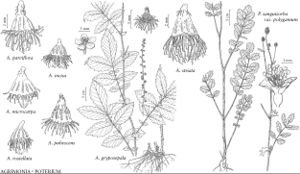Poterium
Sp. Pl. 2: 994. 1753.
Gen. Pl. ed. 5, 430. 1754.
Herbs, perennial [unarmed or thorny shrubs], 1–8 [–40] dm; rhizomatous [taprooted]. Stems 1–10+, ascending to erect, glabrescent to loosely villous [glabrous]. Leaves deciduous [persistent], basal and/or cauline; stipules persistent, adnate to petiole or free, lanceolate to ovate, margins entire or serrate; petiole present; blade oblanceolate to obovate [or elliptic], 1–15 [–35] cm, herbaceous [subcoriaceous], leaflets 2–12 pairs, elliptic, orbiculate, or obovate, margins flat, crenate, serrate, or incised, surfaces glabrous or hairy hairs unicellular to multicellular, acicular and/or gland-tipped. Inflorescences terminal [or axillary] to distal leaves, [15–] 20–100+-flowered, headlike spikes, glabrous or sparsely [to densely] pubescent; peduncles present, sometimes absent; bracts absent; bracteoles present. Pedicels absent. Flowers bisexual or pistillate (plants gynomonoecious [dioecious]), 2–4 [–5] mm diam.; hypanthium dry [fleshy, spongy], top-shaped, ellipsoid, or nearly orbicular, 2–9 mm, angled, winged, and/or ornamented with irregular flanges and papillae, tan to brown, hairy or glabrous; sepals 4, distinct [basally connate], usually ascending or spreading, rarely slightly reflexed, ovate to elliptic; petals 0; stamens 0–30 (–50), shorter or longer than sepals; carpels [1 or] 2 (or 3), glabrous, styles repeatedly branched, brushlike. Fruits achenes, 1 or 2 [or 3], ellipsoid, 1.5–2 mm diam., glabrous (though reticulate and muricate); hypanthium persistent, enclosing achenes; sepals persistent, spreading to slightly ascending. x = 7.
Distribution
Introduced; Europe (especially Mediterranean region), w Asia, n Africa, n Atlantic Islands (Macaronesia), also in s South America, Australia
Discussion
Species 13 (1 in the flora).
Poterium is here circumscribed to include Bencomia Webb & Berthelot, Dendriopoterium Sventenius (all of Macaronesia), Marcetella Sventenius, and Sarcopoterium Spach (of the eastern Mediterranean) based on molecular phylogenetic analyses summarized by D. Potter et al. (2007). The inclusion of these woody Mediterranean and Macaronesian endemics significantly increases the morphological diversity in the genus; see also 25. Sanguisorba.
Selected References
None.
Lower Taxa
"thin" is not a number."dm" is not declared as a valid unit of measurement for this property.
